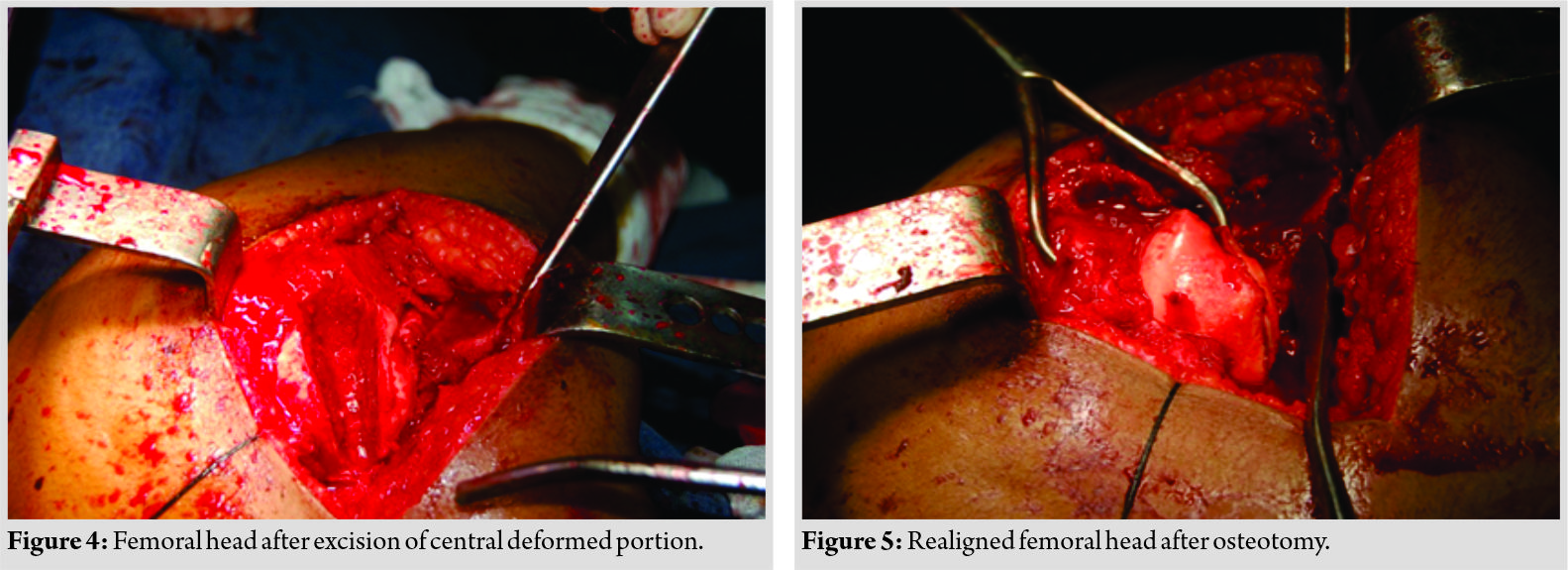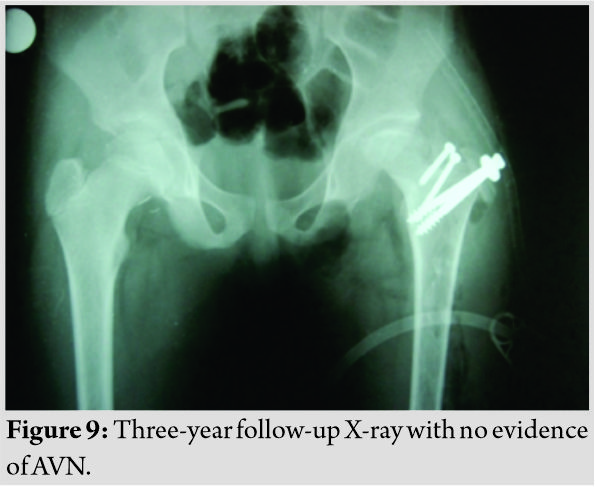[box type=”bio”] Learning Point of the Article: [/box]
Femoral head reduction osteotomy using Ganz safe surgical dislocation of the hip is a safe and effective joint preservation surgery to treat deformed femoral head in adolescent and young adults.
Case Report | Volume 10 | Issue 6 | JOCR September 2020 | Page 32-35 | Praveen Govardhan, R H Govardhan. DOI: 10.13107/jocr.2020.v10.i06.1864
Authors: Praveen Govardhan[1], R H Govardhan[1]
[1]Department of Orthopedics and Arthroplasty, Vasanthi Orthopedic Hospital, Chennai, Tamil Nadu, India.
Address of Correspondence:
Dr. Praveen Govardhan,
Department of Orthopedics and Arthroplasty, Vasanthi Orthopedic Hospital, Chennai, Tamil Nadu, India.
E-mail: rgpraveen2005@yahoo.com
Abstract
Introduction: Perthes disease often results in a non-spherical deformed femoral head which causes pain, dysfunction, early degeneration, and arthritis in young adults. The importance of preservation of native hip in young adults has been well proven. We report a case of deformed Perthes head treated with femoral head reduction osteotomy using Ganz safe surgical dislocation which is a technically demanding but highly rewarding surgical procedure.
Case Report: A 18-year-old female suffering with hip pain and limp for the past 2 years was diagnosed as sequelae of Perthes disease with femoral head deformity. Pre-operative Harris hip score was 54. The patient was planned for joint preservation surgery considering the young age. Ganz safe surgical dislocation was used to expose the hip joint and femoral head reduction osteotomy was done to recreate the sphericity of the femoral head. After 3-year follow-up, the patient had significant pain relief and restoration of function with no evidence of avascular of the femoral head. Post-operative Harris hip score was 82. The treatment of deformed Perthes femoral head remains controversial with no gold standard treatment. Femoral head reduction osteotomy allows the surgeon to reduce the size of the femoral head and restore sphericity of the femoral head preserving the blood supply and helps to improve the functional outcome of the patient. Our case report with 3-year follow-up is evidence to prove the same.
Conclusion: Femoral head reduction osteotomy using Ganz safe surgical dislocation is a safe and effective joint preservation surgery to treat deformed Perthes femoral head in adolescent and young adults.
Keywords: Femoral head deformity, osteotomy, Legg-Calve-Perthes disease.
Introduction
Sequelae of Perthes disease commonly manifests as deformed aspherical large femoral heads which contribute to pain, dysfunction, and early degenerative arthritis in young adults [1]. The importance of preservation of native hip in young adults has been well proven [2]. There have been very few reports of femoral head reduction osteotomy surgical procedure, the reason being the fear of avascular necrosis [3]. This report describes our experience in a private practice setting with correction of the proximal femoral deformity associated with Perthes disease by femoral head reduction osteotomy using Ganz safe surgical dislocation [4] which is a technically demanding but highly rewarding surgical procedure.
Case Report
A 18-year-old thin built (body mass index-21) young Indian lady who is a college student presented to us with complaints of the left groin pain which was insidious in onset and progressive in nature associated with limp for the past 2 years. She had no history of trauma or signs of infection. Laboratory data revealed that her white blood counts, erythrocyte sedimentation rate, and C-reactive protein were within normal limits. Her clinical findings included restricted hip abduction and terminally restricted hip flexion associated with pain. Radiological findings included deformed Perthes like femoral head (Fig. 1).


Discussion
Perthes disease is a self-limiting idiopathic avascular necrosis of capital femoral epiphysis in a child [12], but sometimes results in deformed Perthes head causing pain and early arthritis.. Treatment of deformed Perthes femoral head remains controversial with no gold standard treatment. The prime aim of the treatment is to maintain the sphericity of the femoral head and to prevent secondary degenerative arthritis [13]. Early diagnosis and management can help to prevent the collapse of the femoral head, progressive femoral head deformity, and impingement. The aspherical coxa magna femoral head can be made more spherical by intra-articular osteotomy [4, 13]. Theoretically, if femoral head sphericity can be restored, then the femoral head should last much longer. The Ganz technique femoral head reduction osteotomy helps to reduce the size and restore the spherical shape of the femoral head. The surgical procedure includes Ganz safe surgical hip dislocation which is one of the unique approach of dislocating the femur preserving the vascularity of the head providing an extensile view of a hip joint compared to any other approach [14]. The meticulous attention to detail and soft-tissue handling plays a major role in the success of the procedure. Very few reports of this surgery have been found in the literature. Our experience with this procedure has shown promising results after 3-year follow-up with a significant improvement in Harris hip score and functional range of movements. The only limitation is the number of cases included in the study. Risk of avascular necrosis is significant but can be avoided if the osteotomy is performed correctly with meticulous attention in the preservation of blood supply to the femoral head. The risk of avascular necrosis in a symptomatic patient may be acceptable because there is always an option for future total hip replacement surgery.
Conclusion
Femoral head reduction osteotomy using Ganz safe surgical dislocation is a safe and effective joint preservation surgery to treat deformed Perthes femoral head in adolescent and young adults. Long-term follow-up will determine whether the excellent results will hold up and whether the progress of the disease will be altered by this osteotomy procedure. Further studies and implementation of this surgery by other surgeons and reporting their results would pave the way to femoral head reduction osteotomy of being the gold standard treatment for deformed Perthes head.
Clinical Message
Femoral head reduction osteotomy using Ganz safe surgical dislocation of the hip is a safe and effective joint preservation surgery to treat deformed femoral head in adolescent and young adults.
References
1. Anderson LA, Erickson JA, Severson EP, Peters CL. Sequelae of perthes disease: Treatment with surgical hip dislocation and relative femoral neck lengthening. J Pediatr Orthop 2010;30:758-66.
2. Adler KL, Cook PC, Geisler PR, Yen YM, Giordano BD. Current concepts in hip preservation surgery: Part II–rehabilitation. Sports Health 2016;8:57-64.
3. Siebenrock KA, Anwander H, Zurmühle CA, Tannast M, Slongo T, Steppacher SD. Head reduction osteotomy with additional containment surgery improves sphericity and containment and reduces pain in Legg-Calvé-Perthes disease. Clin Orthop Relat Res 2015;473:1274-83.
4. Paley D. The treatment of femoral head deformity and coxa magna by the Ganz femoral head reduction osteotomy. Orthop Clin North Am 2011;42:389.
5. Nelitz M, Lippacher S, Krauspe R, Reichel H. Perthes disease: Current principles of diagnosis and treatment. Dtsch Arztebl Int 2009;106:517-23.
6. Albers CE, Steppacher SD, Ganz R, Siebenrock KA, Tannast M. Joint-preserving surgery improves pain, range of motion, and abductor strength after Legg-Calvé-Perthes disease. Clin Orthop Relat Res 2012;470:2450-61.
7. Joseph B. Management of Perthes’ disease. Indian J Orthop 2015;49:10-6.
8. Pécasse GA, Eijer H, Haverkamp D, Marti RK. Intertrochanteric osteotomy in young adults for sequelae of Legg-Calvé-Perthes’ disease–a long term follow-up. Int Orthop 2004;28:44-7.
9. Bittersohl B, Zaps D, Bomar JD, Hosalkar HS. Hip arthrodesis in the pediatric population: Where do we stand? Orthop Rev (Pavia) 2011;3:e13.
10. Dror P, David F. Femoral head reduction osteotomy: A case-based approach. In: Pediatric Pelvic and Proximal Femoral Osteotomies. Berlin, Germany: Springer; 2018.
11. Ganz R, Gill TJ, Gautier E, Ganz K, Krügel N, Berlemann U. Surgical dislocation of the adult hip. J Bone Joint Surg Br 2001;8:1119-24.
12. Divi SN, Bielski RJ. Legg-Calvé-Perthes disease. Pediatr Ann 2016;45:e144-9.
13. Burian M, Dungl P, Nanka O, Chomiak J, Ostadal M, Monika F, et al. Anteromedial wedge reduction osteotomy
for the treatment of femoral head deformities. Hip Int 2013;23:281-6.
14. Lazaro LE, Sculco PK, Pardee NC, Klinger CE, Dyke JP, Helfet DL, et al. Assessment of femoral head and head-neck junction perfusion following surgical hip dislocation using gadolinium-enhanced magnetic resonance imaging: A cadaveric study. J Bone Joint Surg Am 2013;95:e1821-8.
 |
 |
| Dr. Praveen Govardhan | Dr. R H Govardhan |
| How to Cite This Article: Govardhan P, Govardhan RH. Femoral Head Reduction Osteotomy for Deformed Perthes Head Using Ganz Safe Surgical Dislocation of Hip – A Case Report with 3-Year Follow-up. Journal of Orthopaedic Case Reports 2020 September;10(6): 32-35. |
[Full Text HTML] [Full Text PDF] [XML]
[rate_this_page]
Dear Reader, We are very excited about New Features in JOCR. Please do let us know what you think by Clicking on the Sliding “Feedback Form” button on the <<< left of the page or sending a mail to us at editor.jocr@gmail.com





